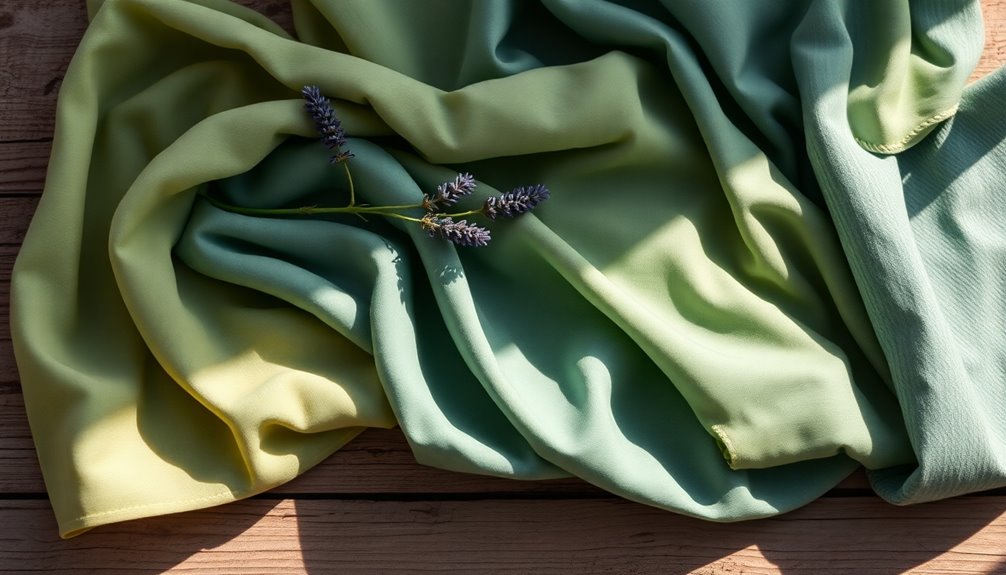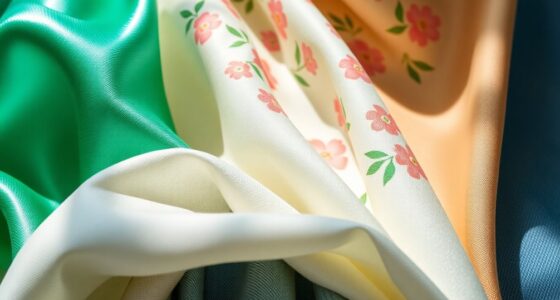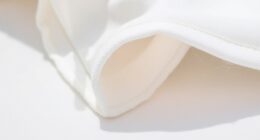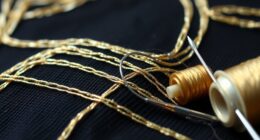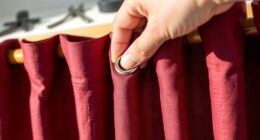When choosing smart materials, you're opting for eco-friendly fabrics that enhance comfort and performance. These textiles, often made from natural fibers or recycled resources, not only minimize irritation and allergic reactions but also lower environmental impact through sustainable production practices. By selecting options like organic hemp or Tencel, you contribute to a circular economy while enjoying durable and stylish garments. Discover more about how these fabrics can redefine your wardrobe and elevate your fashion choices.
Key Takeaways
- Smart materials integrate technology with eco-friendly fabrics to enhance comfort and functionality in fashion.
- Sustainable textiles, like organic hemp and bamboo, reduce environmental impact and promote skin health through natural properties.
- Eco-friendly fabrics, such as Tencel and recycled polyester, are made from responsibly sourced materials and have lower carbon footprints.
- Biodegradable options minimize landfill waste, while recycling potential supports a circular economy in textile production.
- Innovations in smart textiles, such as bacteriostatic properties, enhance garment longevity and reduce odor, benefiting both consumers and the environment.
Understanding Smart Materials in Fashion
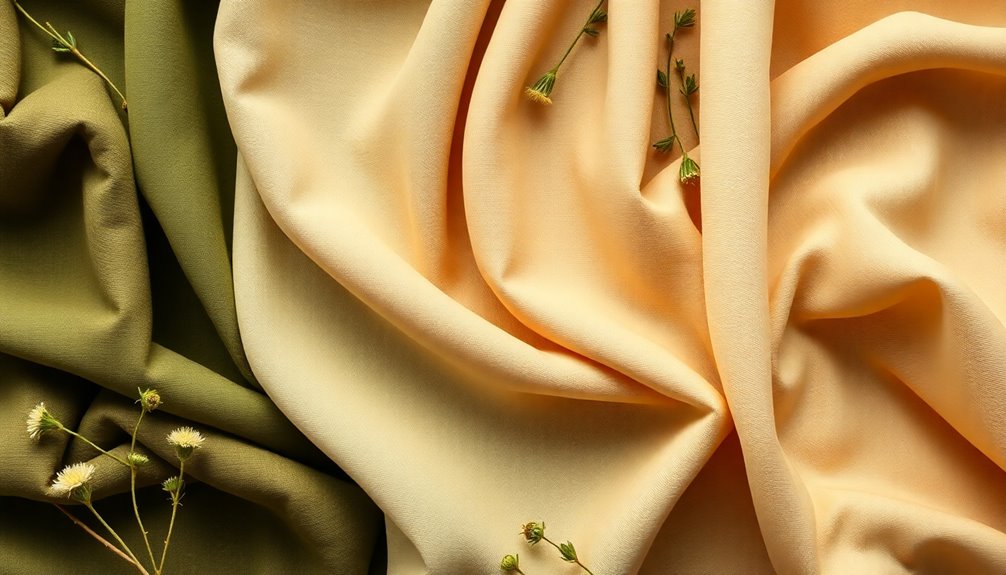
As you explore the world of fashion, you'll find that smart materials are revolutionizing the industry by incorporating advanced technologies like sensors and microchips.
These durable smart textiles respond to environmental stimuli, enhancing properties such as thermoregulation and breathability. By focusing on sustainable materials, you can contribute to reducing resource consumption and waste in your wardrobe.
The production processes for smart textiles prioritize eco-friendly practices and responsible material sourcing, which helps lower the environmental impact. However, integrating electronic components presents recycling challenges, making it essential to design for a circular economy.
The Importance of Eco-Friendly Fabrics
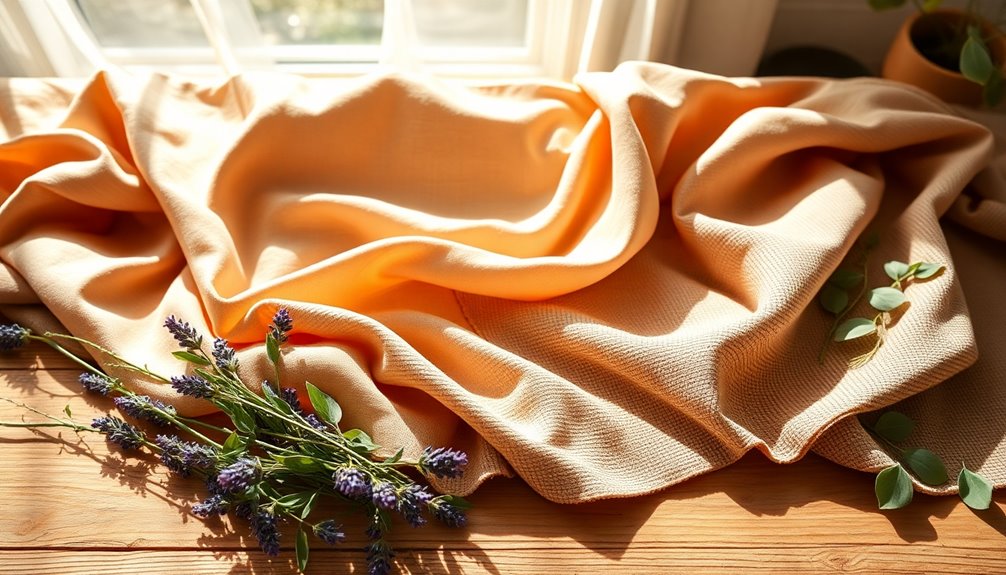
While the fashion industry continues to evolve, the importance of eco-friendly fabrics can't be overlooked.
These materials not only help reduce your environmental impact but also promote ethical practices in production.
Here are three key reasons to take into account eco-friendly fabrics:
- Water Conservation: Choosing organic cotton can save up to 71% more water compared to conventional farming.
- Lower Emissions: Sustainable fabrics like recycled polyester produce up to 75% less CO2 during manufacturing.
- Healthier Living: Natural fibers such as hemp and linen improve indoor air quality, being free from harmful chemicals. Additionally, using natural materials supports a sustainable lifestyle that aligns with eco-friendly practices.
Benefits of Choosing Sustainable Textiles
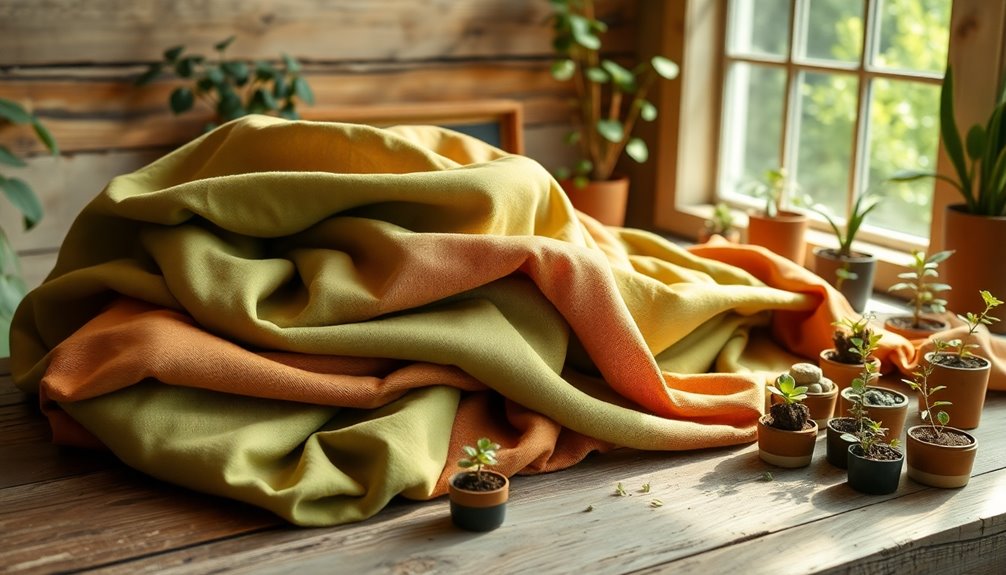
Choosing sustainable textiles is a smart move for your skin and the planet.
These eco-friendly fabrics not only reduce environmental impact but also offer long-lasting durability that saves you money in the long run.
Healthier for Skin
Many people overlook the impact of fabric choices on skin health, but opting for sustainable textiles can greatly reduce irritation and allergic reactions.
When you choose eco-friendly fabrics, you're making a healthier choice for your skin. Here are three benefits:
- Natural fibers like organic cotton and linen are free from harmful chemicals, reducing the risk of irritation.
- Fabrics like hemp and bamboo have naturally antimicrobial properties, helping to prevent bacteria and odor.
- Hypoallergenic materials are often used in sustainable textiles, making them ideal for those with sensitive skin or conditions like eczema. Additionally, using fabrics with antimicrobial properties can further enhance your skin's health by preventing infections and irritations.
Environmental Impact Reduction
When you opt for sustainable textiles, you're not just making a fashion statement; you're actively participating in the reduction of environmental impact.
Choosing sustainable fabrics, like organic cotton and recycled materials, dramatically lowers a brand's environmental footprint, as raw material choices account for two-thirds of the overall impact. These eco-friendly fabrics require considerably less water and energy to produce, conserving essential resources and reducing greenhouse gas emissions.
For example, recycled polyester generates fewer CO2 emissions than virgin polyester, showcasing a lower carbon footprint. By selecting biodegradable options like Tencel and Piñatex, you help minimize landfill waste as these materials decompose naturally.
Ultimately, your choices promote a circular economy in fashion, reducing reliance on finite resources and fostering sustainable production practices.
Long-lasting Durability
Durability stands out as a key advantage of sustainable textiles. By choosing eco-friendly fabrics, you're investing in long-lasting quality that fights against the throwaway culture of fast fashion.
Here are three reasons why durable natural fibers are worth it:
- Extended Lifespan: Sustainable fabrics like organic cotton and hemp greatly outlast conventional materials.
- Resilient Engineering: Fabrics such as Ecotech and Crypton resist fading and stains, reducing the need for replacements.
- Recycled Benefits: Using recycled fibers enhances durability and minimizes waste, promoting a circular economy.
When you opt for these textiles, you're not just reducing environmental impact; you're also ensuring your wardrobe remains functional and stylish for years to come.
Types of Eco-Friendly Fabrics
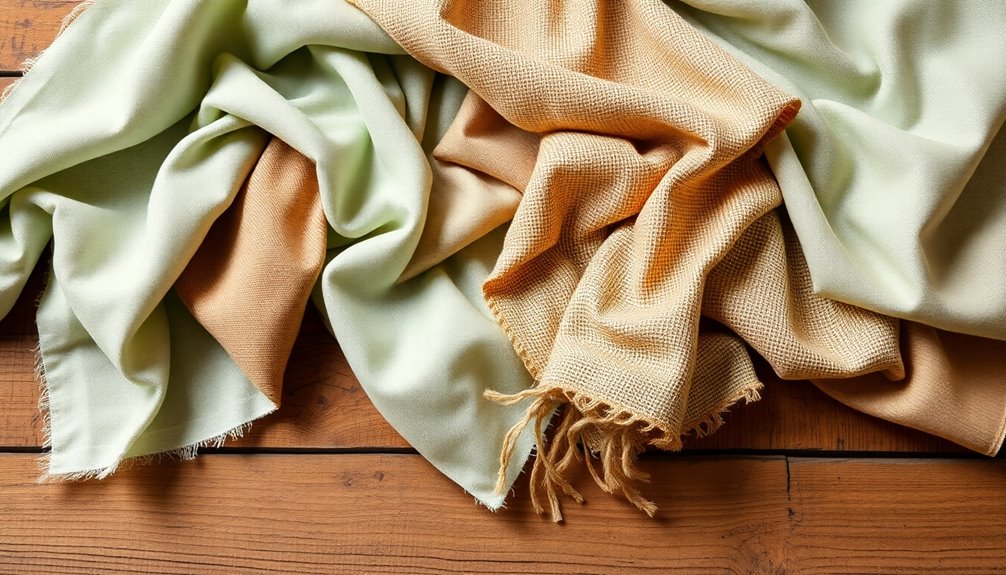
Eco-friendly fabrics come in various types, each offering unique benefits that cater to sustainable fashion enthusiasts. Among these eco-friendly fabrics are organic cotton, hemp, and Tencel, all of which are produced with minimal environmental impact and require less water and pesticides than traditional materials. These options not only promote sustainability but also lend themselves to innovative and stylish designs. For those looking to create their own sustainable wardrobe, exploring ecofriendly textile design ideas can inspire new creations that are both fashionable and kind to the planet.
For instance, organic hemp is strong and durable, needing 50% less water than cotton, while naturally resisting bacteria.
Bamboo fabric is another sustainable option, known for its softness and moisture-wicking properties, making it a comfortable choice.
Tencel, made from sustainably sourced wood pulp, is biodegradable and supports eco-friendly forestry practices.
Recycled Polyester (rPET) stands out as an environmentally friendly alternative, produced from recycled plastic bottles, requiring fewer resources and emitting less CO2 during manufacturing.
Together, these sustainable fabrics contribute to a low carbon footprint, making them ideal choices for those who prioritize eco-conscious living.
How Smart Fabrics Enhance Comfort and Performance

As technology advances, smart fabrics are transforming the way we experience comfort and performance in clothing.
These innovative materials adapt to environmental changes, ensuring you stay comfortable in varying climates.
Here are three key benefits of smart fabrics:
- Moisture-wicking: They keep you dry during physical activities, enhancing your overall comfort.
- Breathability: Advanced designs allow for better air circulation, promoting a cooler feel and improved performance.
- Durability: Lightweight yet strong, these fabrics offer freedom of movement without sacrificing longevity.
Environmental Impact of Sustainable Fabric Choices
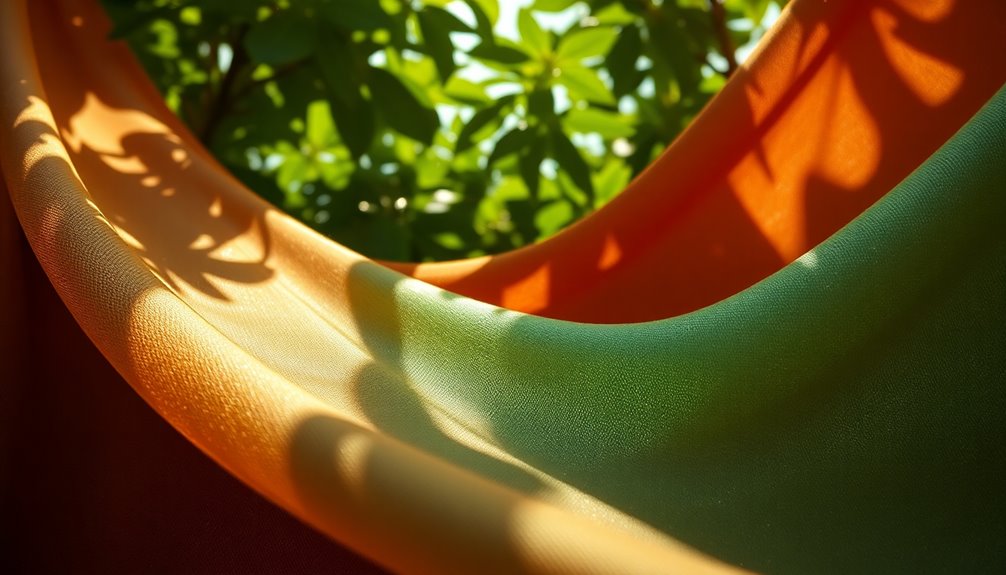
When you choose sustainable fabrics, you're not just making a fashion statement; you're also considering the entire lifecycle of the materials.
These fabrics often consume fewer resources and offer better recycling and biodegradability options, which can greatly reduce their environmental impact.
Lifecycle Assessment Importance
Understanding the environmental impact of fabric choices is essential for anyone looking to make sustainable decisions in fashion.
Lifecycle assessments play a significant role in evaluating how sustainable fabrics affect our planet. Here are three key reasons why they matter:
- Raw Materials Matter: Up to two-thirds of a fabric's environmental footprint comes from raw material choices, highlighting the need for eco-friendly fibers.
- Lower Emissions: Sustainable fabrics, like organic cotton and recycled polyester, show reduced greenhouse gas emissions compared to conventional materials throughout their lifecycle.
- Circular Economy Principles: Effective lifecycle assessments encourage the adoption of materials designed for recyclability, minimizing waste and promoting sustainability.
Reduced Resource Consumption
Choosing sustainable fabrics greatly reduces resource consumption, making a positive impact on the environment.
For instance, organic cotton uses up to 71% less water than conventional cotton, considerably cutting down on water usage.
Fabrics made from recycled materials, like recycled polyester, lower resource demands by reducing CO2 emissions by up to 75% compared to virgin polyester.
Natural fibers, such as hemp and linen, require minimal pesticides and fertilizers, enhancing ecosystem health.
Eco-friendly manufacturing processes emphasize renewable energy, which lowers the overall carbon footprint during production.
Additionally, biodegradable options like Tencel and Piñatex decompose more efficiently than synthetic alternatives, further mitigating waste in landfills. Moreover, the integration of energy-efficient designs in the production of these fabrics can significantly contribute to a more sustainable future.
Biodegradability and Recycling Potential
While many fabrics contribute to environmental degradation, sustainable options prioritize biodegradability and recycling potential, making them a smarter choice for eco-conscious consumers.
Choosing sustainable fabrics helps you support a healthier planet. Here are three key points to reflect upon:
- Biodegradability: Fabrics like organic cotton and Tencel break down naturally, reducing landfill waste without harmful chemicals.
- Recycling Potential: Materials such as rPET lower the demand for virgin resources while offering a second life through recycling.
- Circular Economy: Innovative fabrics like Piñatex promote a closed-loop system, utilizing waste products designed to decompose efficiently.
Where to Find Eco-Friendly Fabrics
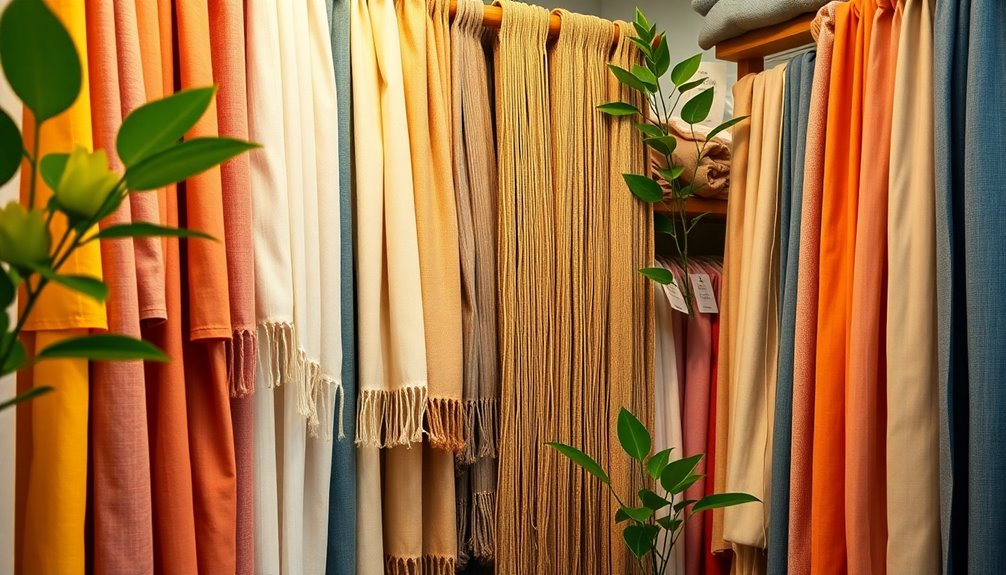
Wondering where to find eco-friendly fabrics? You've got plenty of options!
Online retailers like Folio Fabrics boast over 1,200 sustainable fabrics, including recycled materials with Greenguard Gold certification. Brands like Rare & Fair and People Tree focus on ethical practices and circular economies, offering a variety of eco-friendly textiles.
Check out suppliers that provide Crypton Fabric or recycled fibers made from water bottles to minimize your environmental impact. Many physical fabric stores now curate collections of sustainable fabrics, so you can explore tangible options.
Plus, specialized platforms dedicated to sustainable textiles are popping up, making it easier than ever to access a wide range of eco-friendly fabric options for your next project.
The Future of Sustainable Fashion and Smart Materials
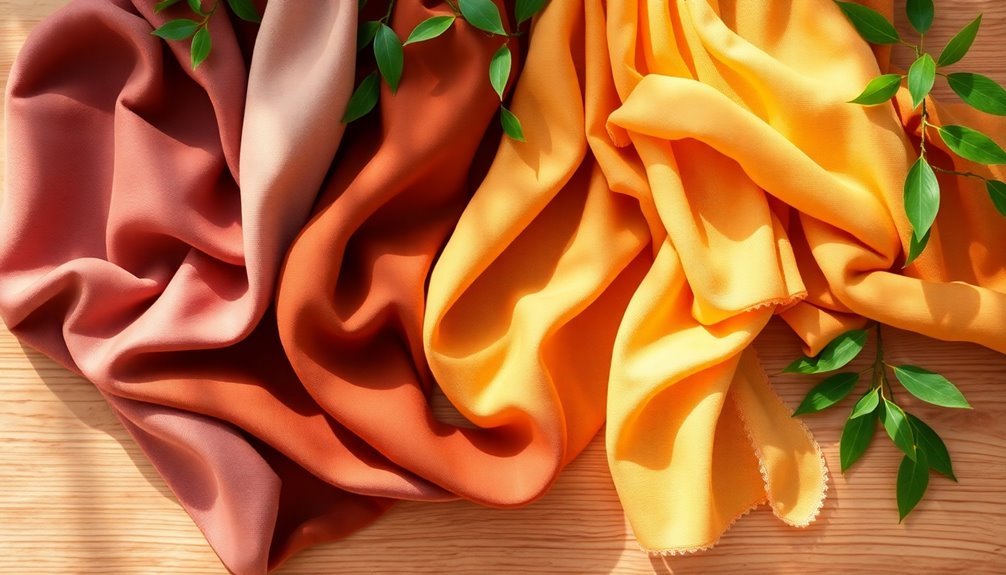
As the search for eco-friendly fabrics expands, the future of sustainable fashion is increasingly intertwined with the rise of smart materials.
These innovative smart textiles utilize technology like sensors, enhancing comfort while relying on renewable fibers to minimize environmental impact.
Here are three key trends shaping this future:
- Bacteriostatic Properties: Smart textiles inhibit bacterial growth, reducing odor and extending garment lifespan.
- Recycled Materials: Brands like Fulgar focus on producing sustainable polyamide yarns, prioritizing ethical production.
- Collaborative Innovations: Partnerships, such as Oysho with BASF and Fulgar, explore synthetic alternatives like Q-CYCLE yarn for responsible textile futures.
Together, these advancements pave the way for a more sustainable fashion industry, blending eco-friendly fabrics with cutting-edge technology.
Frequently Asked Questions
What Are the Best Eco-Friendly Fabrics?
When you're looking for the best eco-friendly fabrics, consider options like organic cotton, which uses less water and avoids harmful chemicals.
Tencel's closed-loop process makes it biodegradable and low-impact.
Hemp fabric's durability paired with its minimal resource requirements is impressive.
Recycled polyester (rPET) repurposes plastic waste, while bamboo fabric grows quickly and needs little water.
Each of these fabrics supports sustainability, making them great choices for your wardrobe and the planet.
What Are the Advantages of Smart Fabrics?
Did you know that smart fabrics can enhance comfort and hygiene, potentially reducing clothing odor by up to 90%?
When you choose smart fabrics, you enjoy temperature regulation and breathability, keeping you comfortable in various environments.
Plus, their bacteriostatic properties help inhibit bacterial growth.
With electrical conductivity, these textiles can even connect with devices for health monitoring.
What Are the Different Types of Smart Fabrics?
When exploring smart fabrics, you'll find several types that enhance your clothing experience.
Phase Change Materials (PCMs) help regulate temperature, while conductive fabrics let you connect with devices for health tracking.
Shape memory alloys adjust to fit you better, and bacteriostatic fabrics keep odors at bay, making them great for workouts.
Finally, self-healing fabrics can mend themselves, extending the life of your favorite garments and reducing waste.
What Are the Benefits of Eco-Friendly Clothing?
When you choose eco-friendly clothing, you're opting for fabrics that are gentle on your skin and the environment.
These materials, like organic cotton and hemp, reduce irritation and promote healthier indoor air quality.
Plus, their durability means you won't have to replace them as often, cutting down on waste.
By supporting sustainable practices, you're also contributing to ethical labor conditions and making a positive impact on the planet.
It's a win-win!
Conclusion
Incorporating eco-friendly fabrics into your wardrobe not only benefits the planet but also enhances your comfort and style. Did you know that the fashion industry produces over 92 million tons of waste each year? By choosing sustainable textiles, you're making a powerful statement and contributing to a healthier environment. As you explore options for smart materials in fashion, remember that each conscious choice you make can lead to a more sustainable future. Let's embrace this change together!
